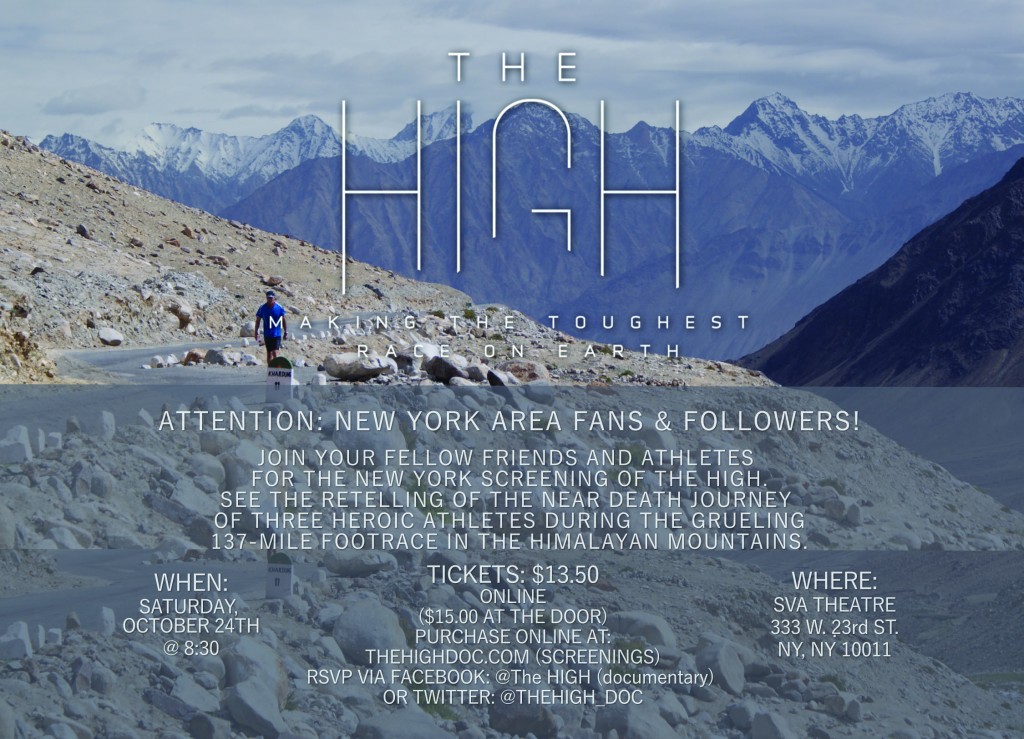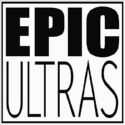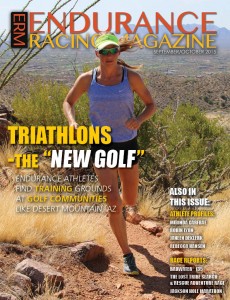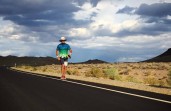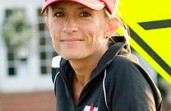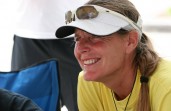By Chelsea H. Bryan
On Lake Anna at 8:30 a.m. on Friday, Oct. 5, 2012, there is a group of swimmers a half-mile away from the boat landing, parallel to the shore; they are nothing but arms, arcing like fish in the air, cutting through the water, glinting in the sun. This group has been swimming for an hour and a half now, and the best of them are still laps—half-mile long laps—away from finishing this swim. And the swim is only the beginning of the trial ahead of them: the Triple IRON triathlon, an epic distance of a 7.2-mile swim followed by a 336-mile bike and a 78.6-mile run.
Twenty four hours from the Triple IRON start time, the Double IRON will begin, with a 4.8-mile swim, 224- mile bike and a 52.4-mile run in store. These are the Lake Anna Double and Triple IRON 2012 events, and despite the whispy rippling clouds of its first morning, the race is not going to be pretty. Sleep-deprivation, blisters, “saddle butt,” chafing, hallucinations, exhaustion, demoralization and grown men crying—that’s what’s ahead.
Compared to what they’ll experience later, this grueling swim is bright and easy; come sunset, they’ll be pedaling through their first long, dark night—and they won’t even finish in the daylight of the next day. In fact, the fastest of the Triple event racers won’t clock out until prime time Saturday night. While the racers freestyle, spectators, such as fathers, wives, one husband and children sit on the Lake Anna shore. They wade to a big orange buoy at the lap turnaround point every fifteen minutes to offer their racer fuel. “Chocolate milk next time!” one lifts his head out of the water to shout. Some swimmers stop and chat, make jokes, say hello to the cluster of spectators on the shore; others don’t stop at all.
Everyone has their plan, their pace, their own exact routine. These triathletes have been training for months or even years on end—they know exactly what they can and cannot eat, how much—if at all—they can sleep during the endurance event and most importantly, what they need to focus on to get through the sheer amount of time they’ll spend racing. As many will echo throughout the weekend: “it’s as mental as it is physical.”
Some, like Triple IRON competitor, David Jepson from Fort Collins, Co. fill that space peripherally. “You have to fill that time with something and what I do is focus on the people around me,” Jepson said. And while most of the ultra triathletes keep close track of their own lap number, few could tell you that of their competitor’s, like Jepson. That’s why when the slated-lead, Beat Knechtle from St. Gallen, Switzerland, was told by the timers that he needed to do another lap as Jepson was coming out of the water, he got concerned. “I knew he was [ahead in the race]. I thought they would figure it out, but they didn’t. At first I was concerned, but I didn’t let it affect me.” He added, “You can take this however you want, but I think it’s nice for Americans to come here and do well.”
Once the last swimmer was out of the water, and all theracers stripped of wetsuits and off on their bikes, all the “crews”—the racers’ support teams, mostly consisting of family members who provide food and liquid, advice and support of every kind—head back to “tent city.” The cluster of lit-up tents surrounding the main timing station and the run and bike turn around point—also the eventual race finish line—was dubbed Tent City by Steve Kirby, event organizer, who “runs around like a chicken with his head cut off,” says John Wall, longtime event volunteer who, like other event volunteers, pulls 10-hour days or more throughout the weekend. Tent City is the community center of the race, the place that feels like a family reunion to the crew members—after all, how many people in the world run ultra triathlons in their spare time? Few enough to bring 10 different international flags to Spotsylvania, Va., a small town which is not exactly an international center of commerce.
By early afternoon, the bikers are pedaling hard and the crews have set up home base under tarp-topped tents where falling acorns rain in sporadic, thumping showers; the puttering is charming during the day, but becomes a trying spook on fried nerves and exhausted crews in the night. To the bikers, the acorn showers sound like animals moving in the woods. But psychological perils are just one among many concerns: without the heat and comfort of the sun, racers have to struggle with hypothermia, hallucinations and plain rock-bottom spirits. And it’s the crew members who must deal with the consequences of all that. While some are cheerful about their role, others find the pressures on both parties trying.
When asked whether she likes crewing, Johan “Taz” Desmet’s wife Hélène says: “It’s his hobby and he just drags me in, so not really, I think it’s too much. I don’t want to let him go on.” However, Hélène sees the bright side of the Lake Anna event too. She says, “What I like about this one is there’s no comparing, ‘look at my bike,’ ‘I have the most expensive bike.’ But it’s gonna be tough, hours on your feet in keeping awake. It’s gonna be hard for me.”
“What I like about this one is there’s no comparing, ‘look at my bike,’ ‘I have the most expensive bike.’ But it’s gonna be tough, hours on your feet in keeping awake. It’s gonna be hard for me.”
Triple IRON racer Tom Melshuish’s father Simon Melshuish, who flew all the way from the UK to meet his son, also takes the cons of crewing to heart. “Sometimes I feel like it’s maybe easier to be the athlete than the crew. You stay up long hours, it gets boring.” I could see the real burden on Simon’s shoulders, however, was having to watch his son go
through pain. He managed to note the pros too: “He traveled from Sydney, I traveled from London… it’s nice to see him, I haven’t seen him since Easter.”
But the real threat of the event is not sleepless hours, hard-tofind vacation days and irritable, emotional racers, but the lurking risk of death—or at least that’s what the infamous case of Caballo Blanco, who died of a heart issue at the age of 58 while running extreme distances with the Mexican Tarahumara tribe, would suggest. When doctors on staff for the event were questioned on the controversial nature of racing, they balked at mentions of arrhythmias, sudden death, scarred heart muscle tissue and the like.
“You read about that; it’s not common,” said Doctor George Wortley. He mentions Caballo Blanco. “Here’s what the data shows: if you’re doing these things, your life is half the all-cause mortality from someone who’s sitting on the couch.” He adds, “If something’s gonna happen, something’s gonna happen. We’ll deal with it.”
Wortley sits right by the turnaround, the perfect place to check in with bikers, who have to slow down to make a u-turn around the orange cone marking the end of each lap. Most bikers don’t stop between laps, which take on average 15 minutes. Crew members trot off, keeping pace with racers, handing them sandwiches, bars, gels, carb-infused drinks—whatever they’ve prepared in the interval. After five or six hours of pedaling, however, most bikers do need to make a pit stop for the dinner meal, hot and steaming stews served up right beside the timing tent, the first landmark in Tent City. Also, bathroom breaks, salves for rash-prevention are needed; but no naps—not yet. The crew members that hailed the IRON as “not intense,”—citing naps, a general lack of cut throat attitudes, etc.—may have been right in a sense. But David Jepson wouldn’t hear it. Intense is the only word to describe him. He stopped for nothing.
By the time of the run, everyone had hit a low. Even the racers whose background was in biking could be seen haggardly slumped, grimacing, towards the end of their 67th lap—or 45th for the Double. During the run, some dropped out or lowered their distance to a Double or “Double Plus.”
But no one was in as much pain as Chris Trimmer, the lone athlete looking to complete a quintuple IRON. The thin, wiry runner—few had seen him at the time of his swim or bike, which took place during the arcane times of Wednesday morning through Thursday night—ran like an energizer bunny, pushing himself with a smile and a wave. Around Saturday evening he couldn’t smile anymore though. Afraid his Achilles might literally tear, he started to consider dropping out. He had decided to race last minute for Wounded Warriors, though, and no one wanted him to fail.
Caroline Brosius, a fellow endurance athlete who was at the timing booth, kept encouraging him, and race doctors told him as long as he kept going at his current pace, his Achilles would be intact. He kept on. As he moved through the Triple IRON, David Jepson kept the lead since coming out of the water. His pace was higher than anticipated on the run, but as his wife Amanda Bestfelt-Jepson said, “He feels good, so he’ll keep going.” She also said, “David is extremely competitive and will bury himself physically. He’s starting to feel sore, mentally he seems in really good spirits.”
This was on Saturday, by which time the Double IRON event was in full swing. Steve Harvey from Plymouth, England and his rival Ghislain Marechal from Braine L’Alleud, Belgium were going at it—Harvey was ahead but Marechal was in second. The two are neck-in-neck for the International Ultra Triathlon Association World Cup, a series of races, some Doubles, some Triples, each with assigned points. Ultra triathletes like Harvey and Marechal race in a series of events, and at the end, the racer with the most points gets the world cup.
But at Lake Anna there was one racer coming in between them— David Bush, from Columbus, Ohio, who beat Marechal to come in second. However in the IUTA, Marechal still has a firm hold on second place with 223 points to Harvey’s 340. Harvey finished at Lake Anna with a low time of 23:53:31; Marechal finished third, at 26:30:59. Bush came in second just an hour over Harvey’s time at 25:06:55; he beat Marechal by almost an hour-and-a-half. While the three Double IRON contenders were biting at one another’s heels, Jepson was actually running—not slogging, or “slow jogging”—on to beat Beat Knechtle by seven-and-a-half hours at a new course record of 39:11:37. Last year’s record holder, Kamil Suran, ran with him in a selfless and excited effort to help Jepson break a new course record. Knechtle came in at 46:36:50. Tristan Vinzent, from Wörrstadt, Germany, considered by some to be the greatest threat to Knechtle’s supposed win, came in third with a time of 49:07:21.
Among all the men vying for the medal was a petite powerhouse named Andi Ramer, hailing from San Diego, Ca. Though she was the only woman officially competing in the race, she raced so intensely it seemed she might beat the boys. She came in first for the women and placed fifth among the men, with a time of 53:05:03.
At the end of the day, 19 out of 22 racers in the Double IRON finished before the cutoff time (two did not finish and a third completed an IRON Plus) and 10 out of 12 contenders in the Triple IRON finished, the other two still completing a Double PLUS for the record. Race Director Steve Kirby says, “The race went well overall, [we] had more people finish the race than we have had in the past.” As Jepson said, “We really appreciate what Kirby’s doing. This is a pretty big production for the $400-500 cost. I mean, do the math.”
Perhaps the most grateful, inspiring and intense racer was Chris Trimmer, who finished his epic Quintuple IRON— five times the IRON distance—with a time of 102:41:00.
He said while running on his fourth day of the race, “When it gets really hard, I just cry and cry, and then when I’m done, I thank God.”
Trimmer ran to benefit Wounded Warriors. When I got the chance to run a lap with him on Saturday, he ended the lap with a word of encouragement, “You’re a warrior,” he said. Maybe the echos around Tent City are true in a way: maybe you really can’t be too intense at the Lake Anna races.


